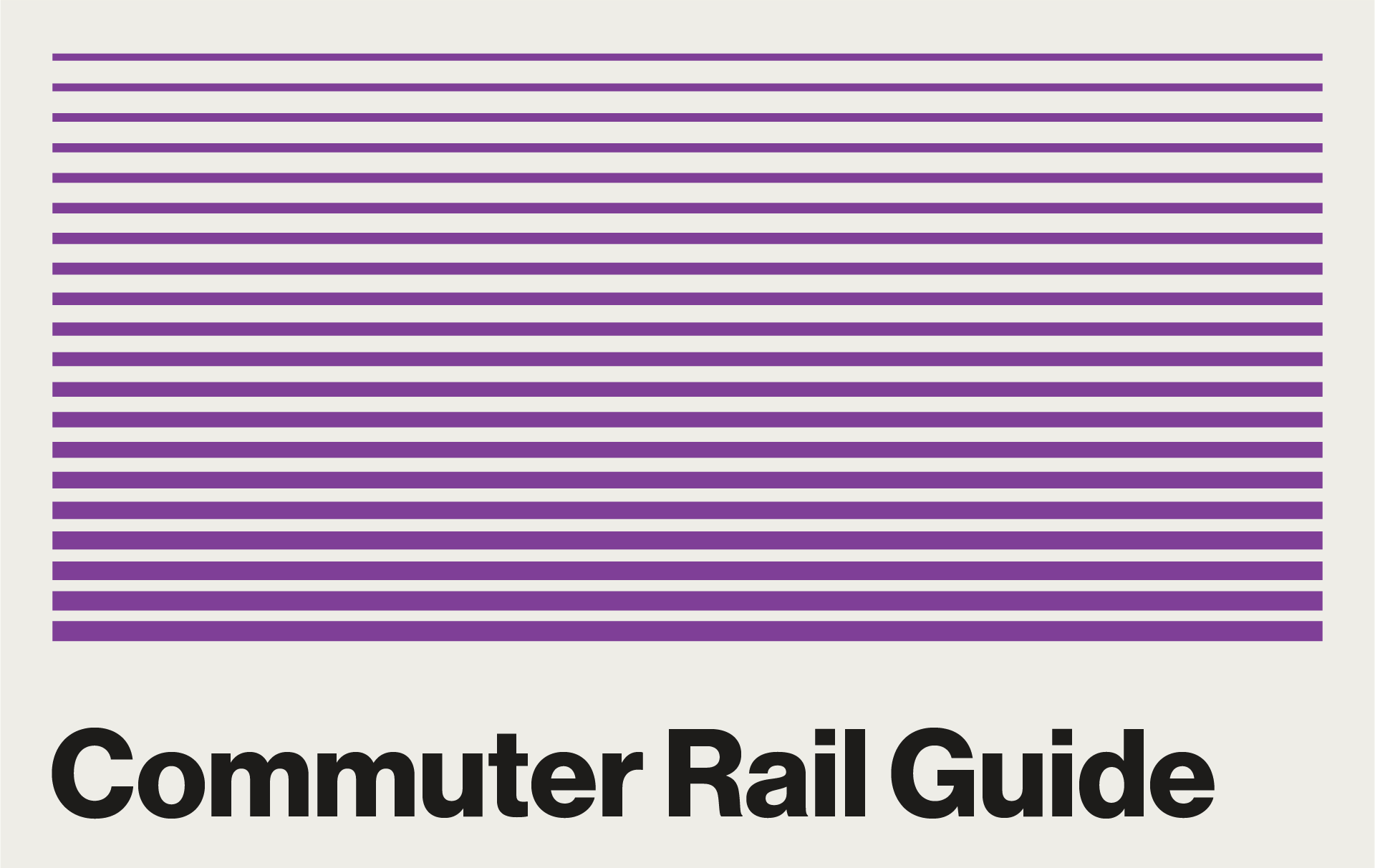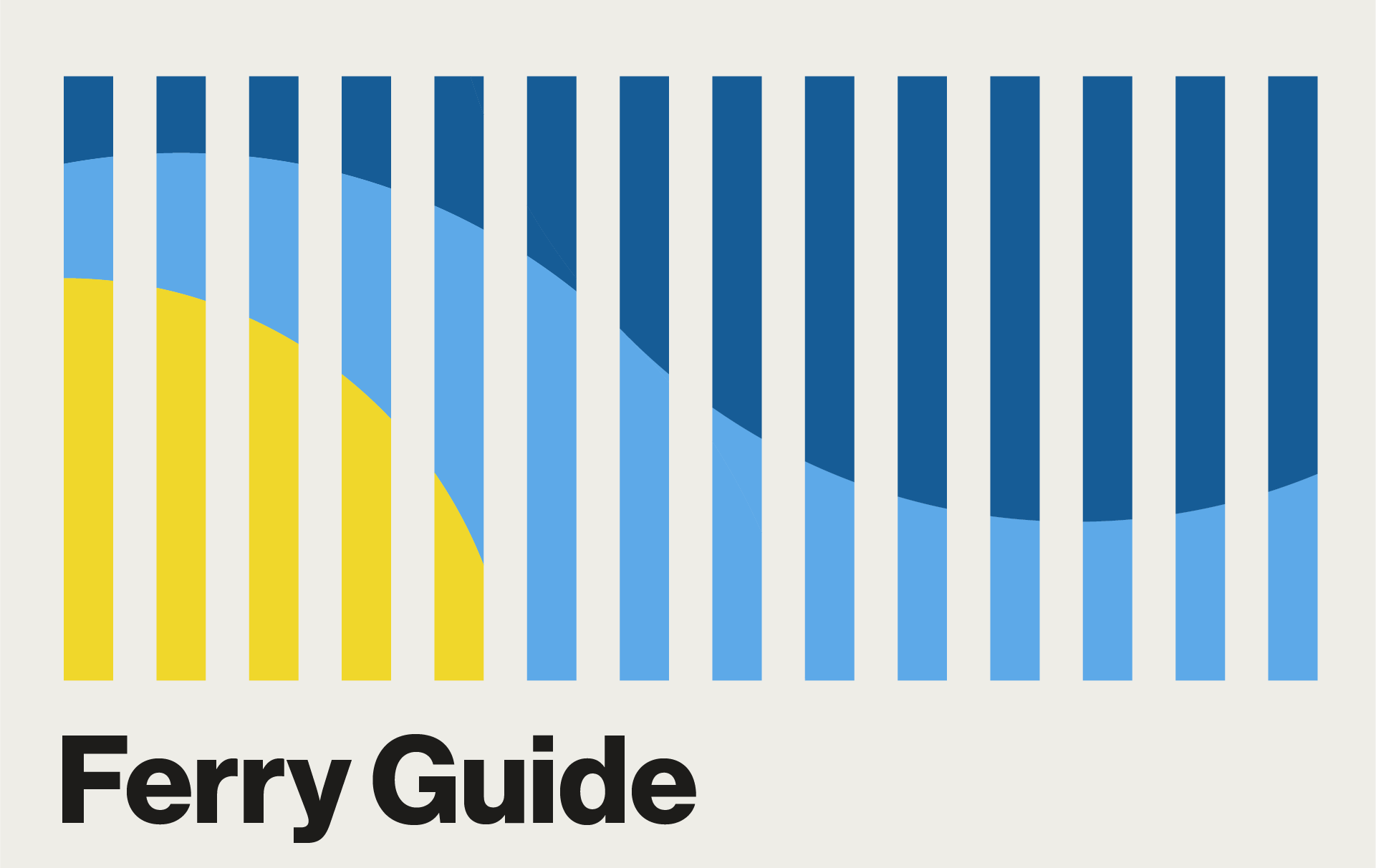Beginner's Guide to the Subway
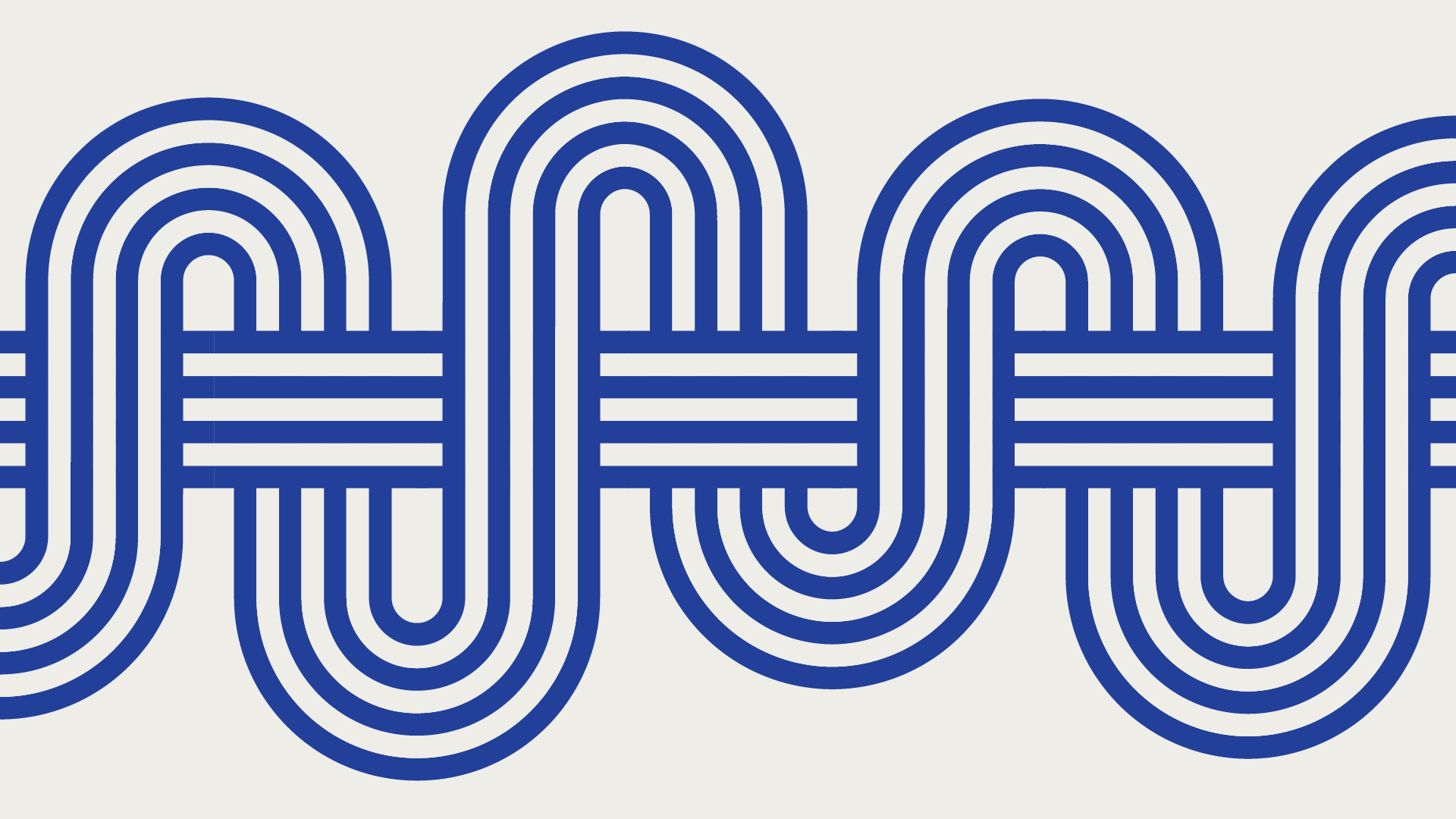
The subway is the largest part of Boston’s public transit system, with more than 700,000 trips each weekday. It is often referred to simply as the T (the “T” from MBTA—the Massachusetts Bay Transportation Authority).
The trains—or trolleys, as they’re sometimes called here—connect downtown Boston to communities within and near the city.
In this guide, we’ll talk about the basics of the system, and we’ll explore each line and where it can take you. Sit back and enjoy the scenery—each line runs at least partially above ground!
Getting to Know the Subway
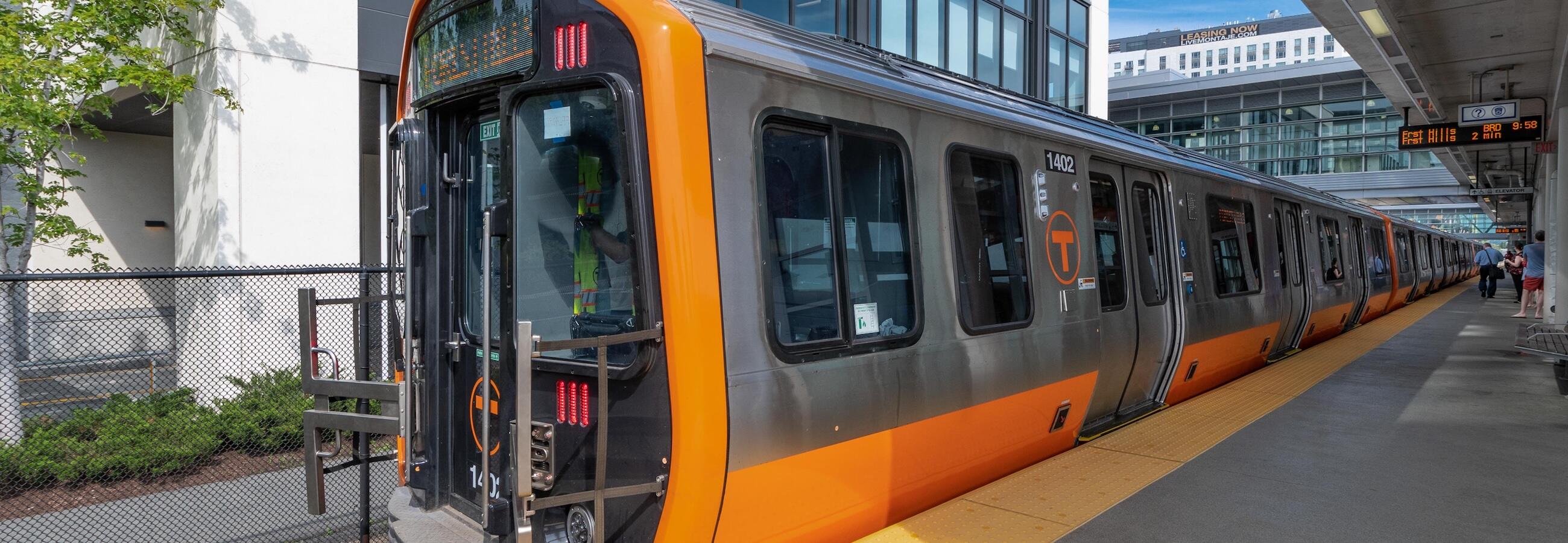
Wherever you’re going in Greater Boston, the T can help get you there. Here are some basics of the subway.
There are four main subway lines—the Green, Blue, Orange, and Red lines—with 125 stops throughout the region.
All routes operate seven days a week, and they all stop near Boston Common, right downtown:
It’s easy to make connections to or from other subway lines, MBTA buses, Commuter Rail, Amtrak, and regional bus services.
Did you know? The country’s very first subway tunnels are still in use today under Boston Common. The Tremont Street subway opened in 1897 as North America’s first subway tunnel. It’s still in use today, connecting Government Center, Park Street, and Boylston stations.
A one-way fare on the subway is $2.40 with a CharlieCard, CharlieTicket, contactless payment, or cash. Reduced fares are available for eligible riders.
Passes for 1 day ($11.00), 7 days ($22.50), or the Monthly LinkPass ($90.00) are also available.
Passes for 1-day or 7-day travel on the subway, Local Bus, Commuter Rail Zone 1A and ferry are also available to buy on a CharlieTicket at the same prices.
Learn more about subway fares and how transfers work
Did you know? The most popular pass for most commuters is the LinkPass, which provides unlimited travel on subway and Local Buses for a calendar month. LinkPasses are now available as a CharlieCard that automatically renews every month.
Most trains run between about 5 AM and 1 AM, and some lines have service as late at 1:50 AM.
Service runs more frequently during rush hour, between 6:30 AM – 9 AM and 3:30 PM – 6:30 PM on weekdays.
Subway schedules are available in several formats:
- On our website: Simply click on any line, and select “schedules from here” under any station. From there, you can see how frequently the train is scheduled to depart, as well as train locations in real time.
- As a PDF: Download the subway schedule PDF, which lists how frequently trains run during different parts of the day.
- Paper printouts: Schedules for all lines are available at Airport, Back Bay, Harvard, North Station, and South Station. Schedules for nearby routes are available at most subway stations, municipal buildings, libraries, and malls. You can also request regular and large-print schedules from Customer Support.
If you have questions about schedules, call Customer Service at 617-222-3200.
The Silver Line is listed alongside train routes sometimes, but it's actually a bus! Some Silver Line stops are underground and use fare gates, just like subway stations.
Passengers traveling on SL1, SL2, and SL3 buses pay the standard MBTA subway fare.
Passengers traveling on SL4 and SL5 buses pay the standard MBTA bus fare.
The easiest way to plan a subway trip is to use our trip planner.
Taking Your Trip
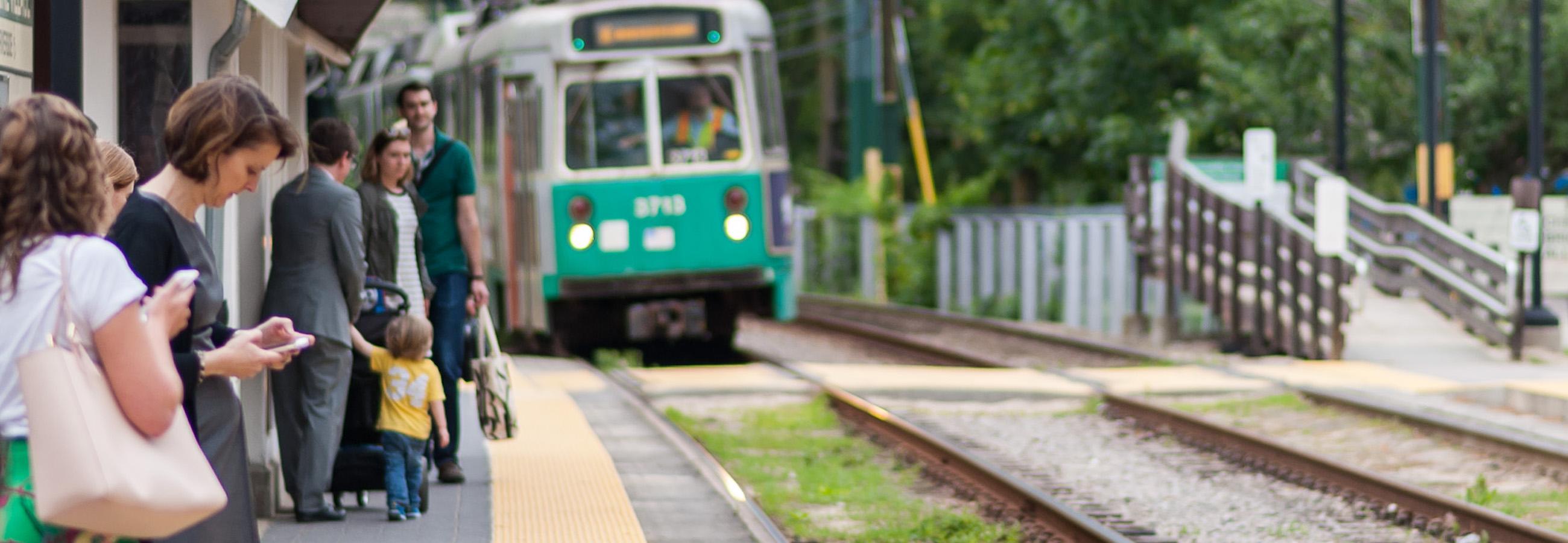
Here are some things to keep in mind at your station or stop, when you board your train, and while on your trip.
There are several options for buying tickets or loading up your CharlieCard.
Fare Vending Machines
You can buy 1-day, 7-day, cash value, and monthly passes for your CharlieCard at fare vending machines. They are located at all subway stations. Fare vending machines accept credit, debit, and cash payments.
If you are planning to also ride the Commuter Rail or the ferry, you can buy a 1-day or 7-day Commuter Rail Zone 1A CharlieTicket to travel on the subway, Local Bus, Commuter Rail Zone 1A and Charlestown ferry.
Retail Sales Locations
Tickets and passes are available at retail stores throughout the region. Stores accept credit, debit, and cash payments.
Online
You can’t load money or passes onto your CharlieCard online, but you can register it with MyCharlie to protect your balance in case it gets lost, damaged, or stolen. You can also sign up for Auto-pay to get a bus or subway pass that automatically renews each month.
You can use your CharlieCard, CharlieTicket, or contactless payment method at a fare gate to access the train platform. At street-level stops on the Green Line and Mattapan Trolley, you’ll pay your fare with your card, ticket, or cash at the onboard fare box at the front door or the contactless readers located at all doors.
We encourage riders using cash to use exact change or to load a CharlieCard at their nearest fare vending machine prior to travel. If you pay more than the required one-way fare, you will not receive change back.
Learn more about paying your subway fare
Did you know? The T has both trains and trolleys. What’s the difference? Trains are used on heavy rail systems (like the Blue, Red, and Orange lines), and trolleys are used on light rail systems (like the Green Line and the Mattapan Trolley).
At stations, there are countdown clocks that offer estimated train and trolley arrival times. Stops above ground may not have these, but schedule information is always available on our website or your preferred trip-planning app.
Each subway schedule page includes real-time arrival info under each station. Or, select your station from this list, and click the Departures tab.
There are also a variety of smartphone apps to help you plan trips on the MBTA.
If trains are delayed for any reason, we’ll post that info on our subway alerts page and each line’s schedule page.
Did you know? You can get notifications about delays and planned disruptions for the routes and services you use most with T-Alerts. T-Alerts are delivered via email or text message.
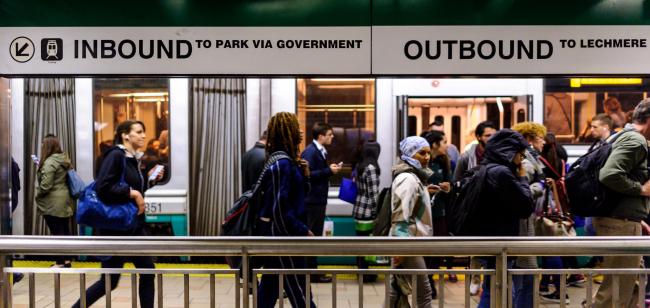
Inbound is always toward the 4 stations near Boston Common:
Outbound service travels away from those stations.
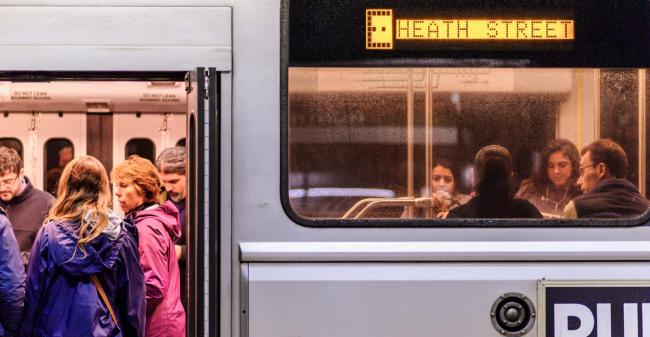
The T gets crowded. We ask customers to follow a few rules for the comfort and safety of everyone on board:
- Let passengers exit the vehicle before attempting to board, especially during rush hour.
- When boarding, please move all the way into vehicle, as far away from the doors as possible. This helps make room for other passengers.
- Only take up one seat. If you have a seat and no other seats are available, please offer your seat to older adults, pregnant women, and people with disabilities.
- Take off your backpack, and keep large personal items on the floor and out of the way.
Service animals are allowed on the T at all times. Allowing animals off leash, out of carriers and/or taking up vehicle seats is not permitted.
During the peak hours of 7 AM – 9 AM and 4 PM – 7 PM, non-service, small, domestic animals should be in a secure animal carrier. Please keep carriers on your lap if possible and away from vehicle doors, especially during rush hour. Larger pet dogs that cannot fit in a carrier are prohibited during this time. During the off-peak hours of 9 AM – 4 PM and after 7 PM, large pet dogs are permitted. Larger dogs should be leashed at all times.
Riders should avoid bringing pets onto the T during holidays or large events, such as the Boston Marathon. MBTA personnel have the right to restrict pet access to T vehicles and stations within their own judgment due to conditions such as crowds or the animal’s behavior.
Bikes are not allowed on the T during peak hours, 7 AM – 10 AM and 4 PM – 7 PM on weekdays, and they’re never allowed on the Green Line or Mattapan Trolley.
All upcoming stops are announced over an intercom system. All trains have full system and line maps posted inside each car, and some have digital screens onboard that show what stop is next.
You do not need to request your stop on a Red, Orange, or Blue Line train, or on the Green Line when it’s underground—trains stop at every station.
When Green Line trains are running at street level, you will need to request a stop. Press the yellow or black tape near the windows, or pull the gray cable near the ceiling of the train.
Request a stop on the Mattapan Trolley by pulling the cable near the ceiling.
Every MBTA staff member is trained on emergency procedures and preparedness.
If you see something suspicious or need to report an emergency, please dial 911 or call the Transit Police at 617-222-1212.
Fare Calculator
Choose your origin and destination to calculate your fare with our Trip Planner.
The Green Line
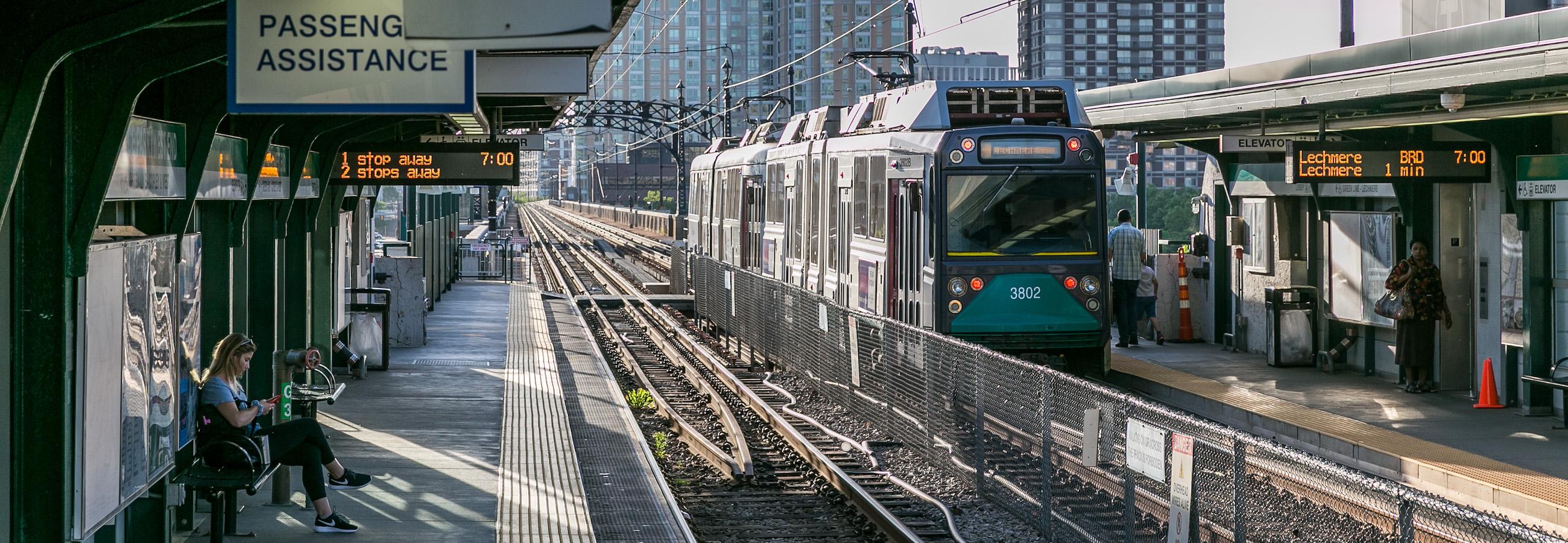
The Green Line serves an average of 93,000 customers each weekday. This light rail line has four branches to the west and north of Boston, connecting eight different cities and towns to the downtown area.
The Green Line got its name because it travels through Boston’s Emerald Necklace park system.
The four branches of the Green Line include stops in:
- Allston
- Brighton
- Boston
- Brookline
- Cambridge
- Mission Hill
- Newton
- Somerville
- Medford
All trains stop at:
Did you know? The Green Line used to have an A branch! It split off from the B branch and ran to Watertown down Brighton Avenue. It was replaced by the 57 bus in 1969.
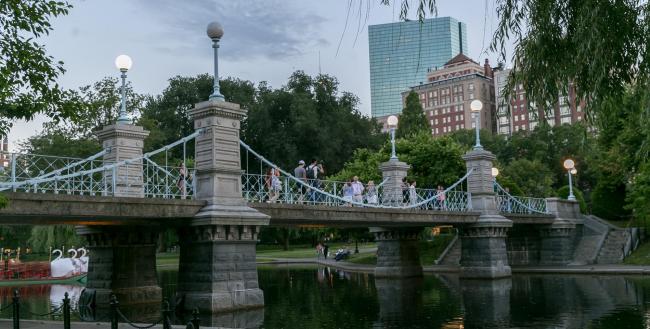
All of the Green Line trolleys reach:
At Symphony, Symphony Hall is home to several of Boston’s musical institutions:
Find some of Boston’s biggest museums are also on the E Line:
- Museum of Fine Arts (Museum of Fine Arts)
- Isabella Stewart Gardner Museum (Museum of Fine Arts)
- Museum of Science (Science Park)
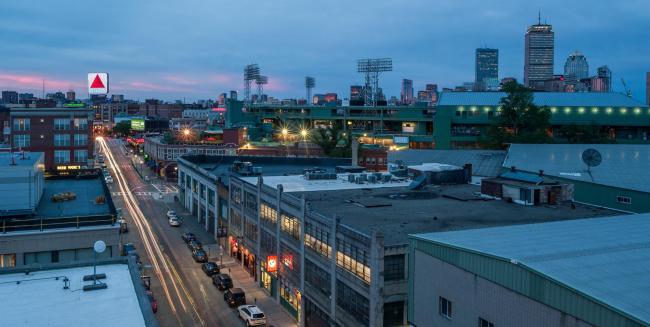
Sports fans will find:
- Fenway Park, the home of the Red Sox, at Kenmore
- TD Garden, the home of the Celtics and the Bruins, at North Station
The C Line runs parallel to the Boston Marathon course, which takes place each Patriots Day—the 3rd Monday in April each year.
And as for Boston’s beautiful Emerald Necklace? Access landscape architect Frederick Law Olmstead’s gem via the D Line or E Line, which run alongside it.
Along the Green Line, you’ll find:
- Bay State College
- Berklee College of Music
- Boston Architectural College
- Boston College
- Boston University
- Emerson College
- Emmanuel College
- Fisher College
- Harvard Medical School
- Harvard School of Dental Medicine
- Harvard T.H. Chan School of Public Health
- Hult International Business School
- Massachusetts College of Art and Design
- Massachusetts College of Pharmacy and Health Sciences
- Newbury College
- New England School of Law
- Northeastern University
- Simmons University
- Suffolk University
- Wentworth Institute of Technology
- Tufts University
Did you know? The T works with colleges and universities to provide discounts on semester-long MBTA passes for students through the Semester Pass Program.
The Green Line meets the Orange Line at Haymarket and North Station. It meets the Blue Line at Government Center. And it meets the Red Line at Park Street.
The Orange Line
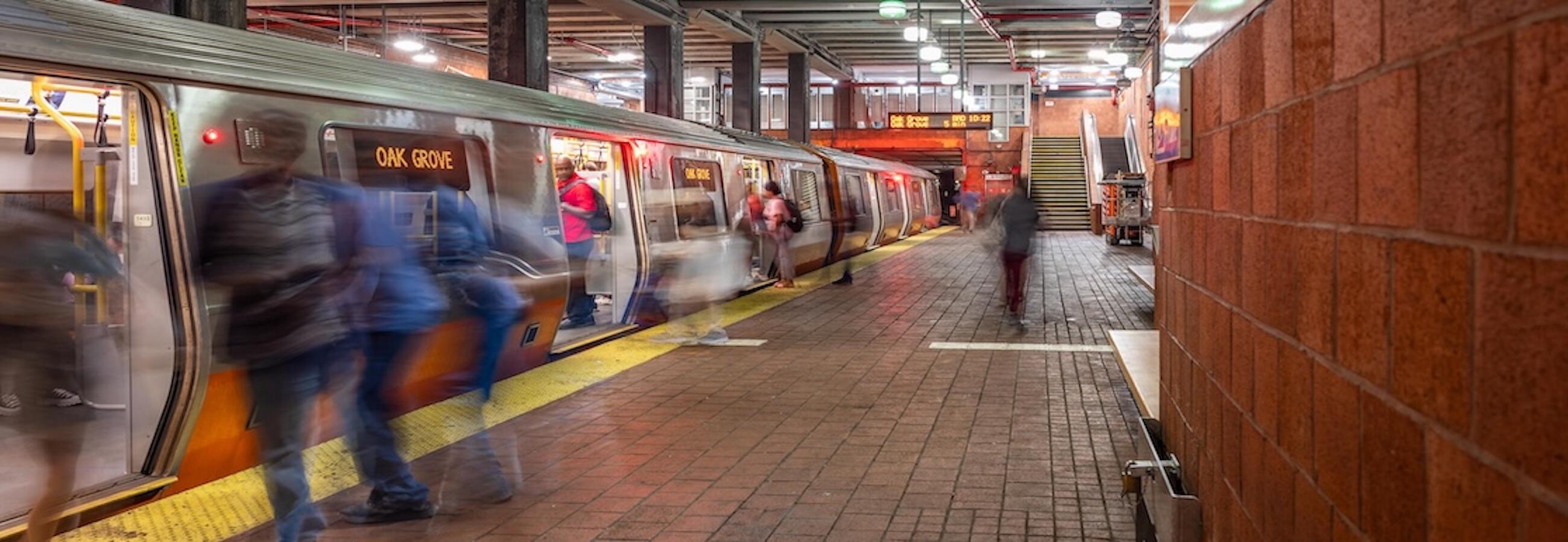
The Orange Line serves an average of 96,000 customers each weekday. This heavy rail line runs south from Malden through downtown Boston and into the Jamaica Plain neighborhood.
The Orange Line gets its name from its route under Washington Street, which was formerly named Orange Street, via Downtown Crossing, Chinatown, and Tufts Medical Center.
The Orange Line includes stops in:
- Boston
- Jamaica Plain
- Malden
- Medford
- Mission Hill
- Roxbury
- Somerville
At Haymarket Station, many Boston landmarks are close by:
- Haymarket, Boston’s oldest outdoor market
- The Rose Kennedy Greenway
- The North End, Boston’s Little Italy
- Paul Revere’s House
- The Old North Church
- City Hall Plaza
- Faneuil Hall Marketplace
At North Station, you’ll find TD Garden, the home of the Celtics and the Bruins.
At Chinatown and Tufts Medical Center, you’ll find Boston’s Theater District.
Chinatown Station is also steps from Boston’s historic Chinatown.
For shopping and dining destinations, check out:
- Downtown Crossing, surrounded by many shops, restaurants, and bars
- Assembly, the gateway to the outlets at Assembly Row, retail stores, and restaurants
Along the Orange Line, you’ll find:
- Bay State College
- Benjamin Franklin Institute of Technology
- Bunker Hill Community College
- Roxbury Community College
- Suffolk University
The Orange Line meets the Red Line at Downtown Crossing. It meets the Blue Line at State Street. And it meets the Green Line at Haymarket and North Station.
The Red Line
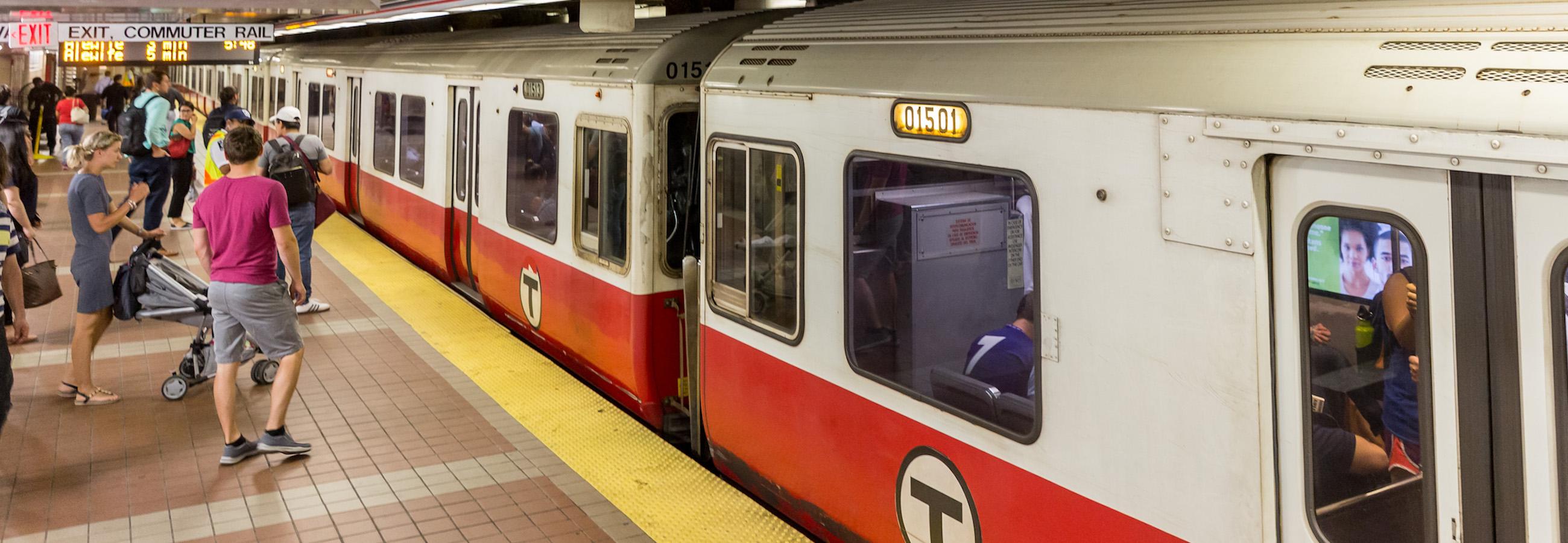
The Red Line serves an average of 122,000 customers each weekday. This heavy rail line runs south from Cambridge into Boston and South Boston, and branches into two sections south of JFK/UMass. The Braintree branch travels through Quincy (on the South Shore), and the Ashmont branch travels through Boston’s Dorchester neighborhood. From Ashmont, the Mattapan Trolley offers light rail service to Milton.
The Red Line got its name because it travels through Harvard University, home of the Crimson.
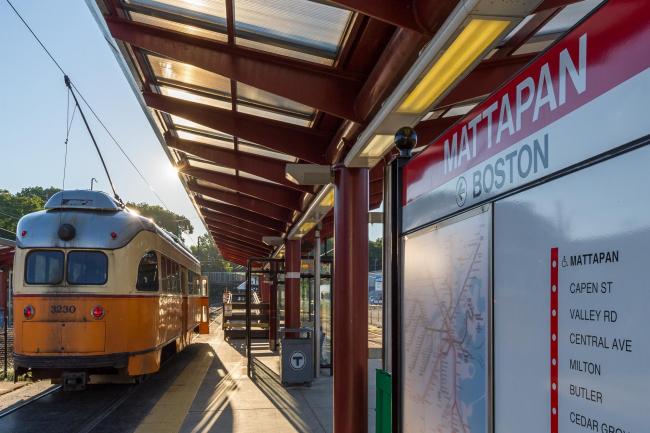
The Mattapan Trolley provides light rail service from Dorchester to Mattapan as an extension of the Red Line.
Customers can transfer to the Mattapan Trolley at Ashmont. If paying with a CharlieTicket or CharlieCard, you can make 1 transfer for free within 2 hours of your first payment. No transfers are available when using cash.
The trains along this route are from the Presidential Conference Car (PCC) fleet, built in 1945-46. Riding the 2.5-mile line is like taking a trip back in time.
Did you know? The MBTA’s light rail system, including the Mattapan Trolley and the Green Line, ranks 2nd in ridership nationwide.
The Red Line includes stops in:
- Boston
- Braintree
- Cambridge
- Dorchester
- Mattapan
- Milton
- Quincy
- Somerville
- South Boston
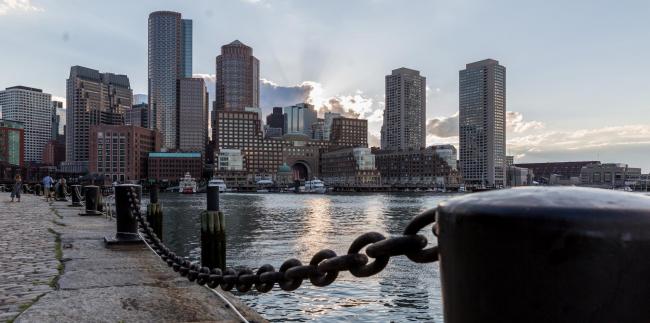
At South Station, many Boston landmarks are close by:
At Park Street, historic sites are just steps away:
- Boston Common
- Public Garden
- Beacon Hill
- State House
At Downtown Crossing, check out shopping and dining destinations
At Charles/MGH, the Charles River Esplanade is right across the street.
At JFK/UMass, make your way to the John F. Kennedy Presidential Library and Museum and the Edward M. Kennedy Institute for the United States Senate. They are side-by-side and about a mile away. Free shuttle service is provided from the station during the day.
Along the Red Line, you’ll find:
- Emerson College
- Harvard University
- Lesley University
- Massachusetts Institute of Technology
- New England School of Law
- Quincy College
- Suffolk University
- Tufts University
- University of Massachusetts Boston
The Red Line meets the Green Line at Park Street. It meets the Orange Line at Downtown Crossing.
The Blue Line
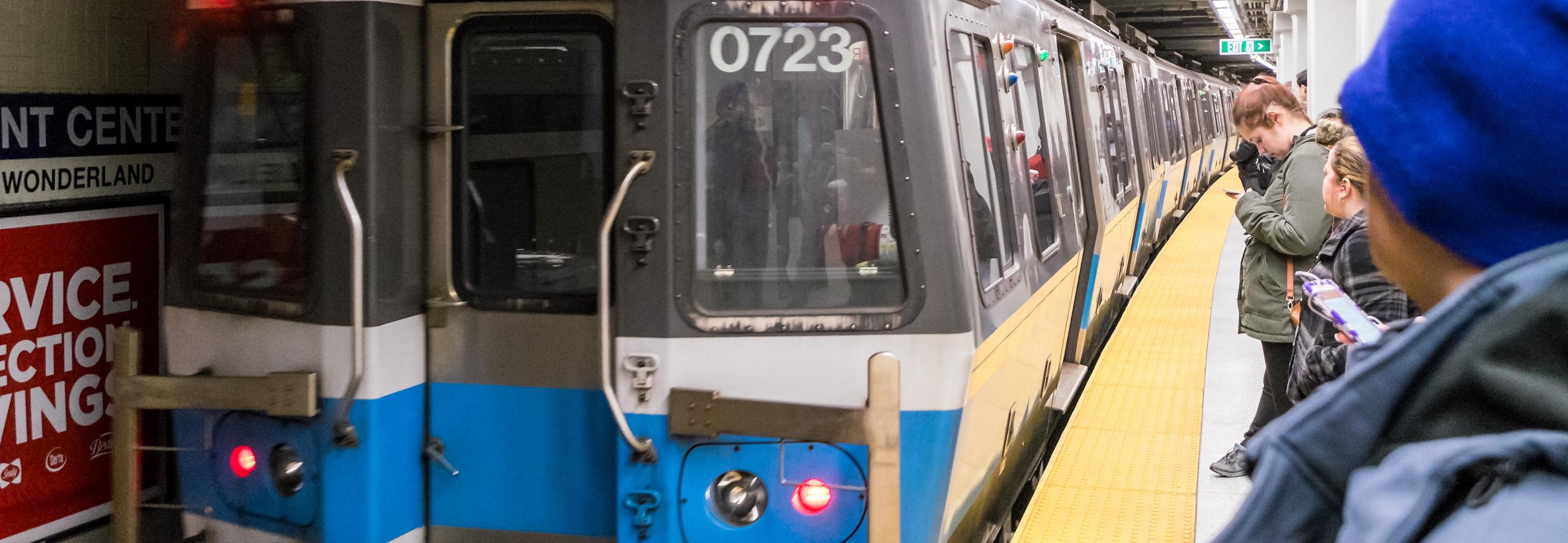
The Blue Line serves an average of 39,000 customers each weekday. This heavy rail line travels from Revere, on the North Shore, into Boston, where it ends near the historic Beacon Hill neighborhood.
The Blue Line got its name because it travels underneath Boston Harbor and along the Atlantic Ocean.
The Blue Line includes stops in:
- Boston
- East Boston
- Revere
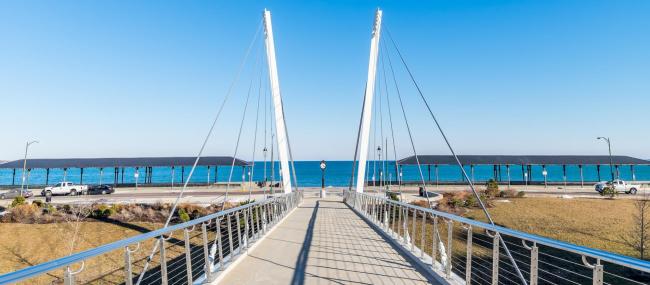
At Revere Beach and Wonderland, see the beauty of the ocean and hit the beach.
At Suffolk Downs, check out Belle Isle Marsh Reservation, Massachusetts’ last remaining salt marsh.
At Aquarium, many Boston landmarks are nearby:
- Rose Kennedy Greenway
- Christopher Columbus Waterfront Park
- New England Aquarium
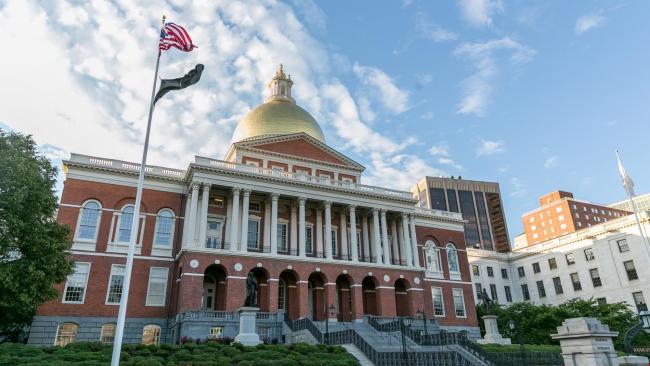
Bowdoin is at the base of Beacon Hill and a short walk from:
- Massachusetts State House
- Historic Charles Street
- Museum of African American History
And Government Center is on City Hall Plaza, which is across the street from Faneuil Hall Marketplace.
Along the Blue Line you’ll find:
- New England School of Law
- Sattler College
- Suffolk University
The Blue Line meets the Green Line at Government Center. It meets the Orange Line at State.
Planning an Accessible Trip
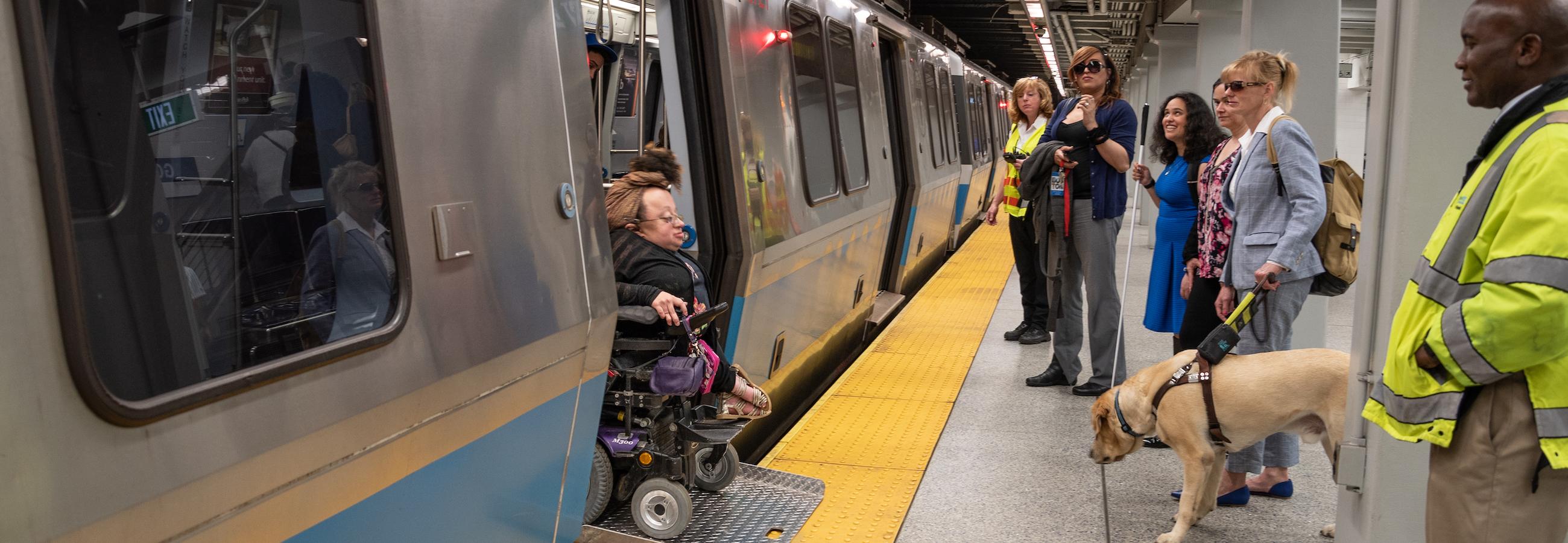
Many subway stations are accessible to people with disabilities, and we offer trip planning assistance to help you get the most out of your journey on the MBTA.
If you are 65 or older or a person with a disability, you may be eligible for reduced fares.
Most, but not all, subway stations are accessible to people with disabilities. Some above-ground trolley stops are also accessible.
You can check station accessibility before your trip by visiting our list of Subway stations. Stations marked with the International Symbol of Accessibility (ISA or "wheelchair symbol") are accessible to people with disabilities.
We’d be happy to help you plan an accessible trip. Call our Customer Support team at 617-222-3200 or 617-222-5146 (TTY).
Learn more about planning an accessible Commuter Rail trip by visiting our access guide.
Yes. People with disabilities and people 65 and older are eligible for reduced fares on the subway with a Transportation Access Pass (TAP) or a Senior CharlieCard. A one-way fare is $1.10, and monthly passes are available for $30.
You can add value or passes to your card at fare vending machines, ticket windows, and retail sales locations.
People who are blind or have low vision ride all MBTA services for free with a Blind Access Card.
Learn more about reduced fares
If you are enrolled in a reduced fare program, you can link your benefits to your form of contactless payment.
Fare Calculator
Choose your origin and destination to calculate your fare with our Trip Planner.


